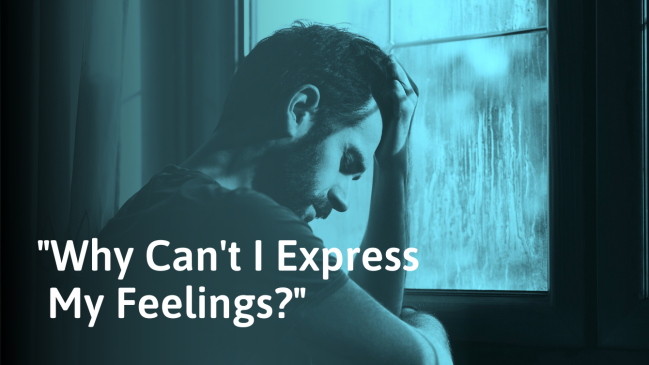Being able to express our emotions in a healthy and constructive way is essential to all of our relationships. It can also be a huge factor in how we take care of ourselves.
We’re going to look at why expressing our emotions is important, how to express them to others, and other ways to let your feelings out.
Sections
- Why is it important to express our emotions?
- How to express your emotions in a healthy way
- 7 methods to express your emotions without talking to someone
- Common questions
Why is it important to express our emotions?
There are many reasons that it is important to be able to express our emotions.
1. Expressing your emotions helps your physical health
Suppressing or hiding emotions harms your health. Suppressed emotions can lead to increased blood pressure,[1][2][3] increased risk of cancer[4][5][6] and cardiovascular disease,[7][8][9] and greater vulnerability to pain.[10][11][12]
Finding a way to express your emotions that feels safe and natural can help improve your health in all of these areas.
2. Expressing your emotions is honest
You may never have thought about it this way, but hiding your emotions is limiting the honesty of your communication. If you’re not willing to talk about your emotions, or you are only willing to show “acceptable” emotions, you’re not showing people who you really are. This harms our romantic relationships, our friendships, and our self-image.[13][14]
3. Expressing emotions helps you get what you need
If you aren’t willing to convey what you’re feeling, it can be difficult for others to understand what you need. Hiding negative emotions, such as fear or sadness, means that other people don’t have the opportunity to offer you the support or reassurance that you need… and that they want to provide.
4. Expressing your emotions can help you handle them
Everyone processes their emotions differently,[15] but you can’t deal with something you don’t know is there. Finding a way to express your emotions, even if only to yourself, is the first step to being able to work through them.[16]
How to express your emotions in a healthy way
There are three stages to being able to communicate your emotions in a way that is healthy, both for you and for the person you’re sharing them with. The first step is to understand what you’re actually feeling. The second step is to learn to accept your emotions. Only once you know what you’re feeling and accept those feelings as real and valid can you communicate them to someone else in a way that is honest and constructive.
Here are 3 steps to express your emotions to others in a healthy way:
1. Recognize what you’re feeling
Understanding what you are actually feeling might sound easy, but it can be surprisingly difficult.[17] There might be emotions that we feel are “unacceptable,” and so we try to hide them from ourselves.[18] Alternatively, you might be so used to suppressing your feelings that you struggle to identify them when they seep through.[19] Here are our top tips to help you recognize your emotions.
1.1 Take your time
As frustrating as it might seem, understanding your emotions can take time.[20] You might be familiar with the idea that we can think we’re hungry when we actually need a drink (although this may be environmental rather than biological).[21][22] but we can also get our emotions confused in the same way.[23]
Expecting ourselves to “just know” what we’re feeling doesn’t help. Instead, try to spend some time alone to think about what you’re feeling or discuss it with a trusted friend.
1.2 Be inquisitive
If you’re not always sure what you are feeling, become your own detective. Remind yourself that you really want to understand your emotional state and devote some energy to the process.
Try not to accept knee-jerk answers. There are often multiple layers to your emotions, and you want to understand as many as you can. Try asking yourself, “I wonder what drives that?” to get to the underlying feelings.
For example, if you realize that you become angry when your partner talks to someone else, ask yourself what might be driving that anger. You might realize that your anger is masking feelings of insecurity or resentment over a lack of time and attention.
1.3 Keep a journal
Journalling can help you to get in touch with your feelings and moods.[24][25] Spending some time each day writing about your thoughts and feelings encourages you to think about how you are feeling, even when you’re not actively writing. You develop a habit of examining your own emotions and trying to put them into words.
Journaling can also help you to identify the root causes behind your emotions or moods. For example, you might realize that seeing a particular friend leaves you feeling insecure for a few days afterward while going to a favorite place might leave you feeling confident or relaxed.
1.4 Look out for “lightbulb moments”
Therapists refer to “lightbulb moments” as times when you make a sudden realization.[26] These can often help us understand something quite deep about our feelings and our beliefs about the world.
For example, someone with PTSD might notice that they aren’t hyper-alert when they are with a specific person. Being with that person will feel strange because they are usually constantly on guard. The lightbulb moment comes when they realize that this “strange” relaxation is actually what everyone else would think of as normal.
If you have a lightbulb moment where you realize something about yourself and your feelings, try to set aside some time to really think deeply about what you have learned.[27][28] What does it tell you about yourself?
1.5 Don’t worry about what you “should” be feeling
You can’t understand what you are actually feeling if you are too concerned with what you should be feeling.[29] Try not to let your beliefs about acceptable emotions get in the way of understanding what is really going on.
Try imagining yourself as a doctor. Your first job, before you can begin to suggest treatments, is to diagnose what is really going on. If you find yourself becoming anxious over what you’re feeling, take a deep breath and remind yourself, “I’ll deal with any problems later. Right now, I’m just trying to understand what is going on.”
1.6 Practice mindfulness
You’ve probably felt the effects of mindfulness, even if you wouldn’t have called it that. Mindfulness is about really paying attention to how you are feeling in the moment. This might be through meditation, yoga, breathing exercises, or even just taking a walk in the park without your phone. Try to set aside a little time every day for some kind of mindfulness.
2. Accept your emotions
Some emotions are easier to accept than others, but they’re all valid and important.[30] Learning to accept your feelings is important if you want to express them. Here is how you can learn to accept your emotions:
2.1 Remind yourself that emotions aren’t actions
One of the reasons that we feel bad about specific emotions is that we don’t always draw a distinction between what we feel and how we act. For example, we might think that being jealous is bad because jealous people stop their partners from seeing friends.
Your feelings aren’t ever right or wrong. They are simply a fact. Rather than struggling with what you should be feeling, focus on your ability to choose what you do about those feelings.[30]
For example, if you are feeling jealous, you might ask your partner not to see their friends. That’s probably not a great solution for a stable relationship. Instead, you could decide to talk to your partner about how you are feeling and ask them for additional reassurance, or you could talk to a therapist about why you feel jealous and devise some coping strategies.
2.2 Understand that we need a range of emotions
Many of us distinguish between positive and negative emotions, but we actually need the full range of emotions.[31] Some things will bring us joy, and other things will make us sad. We might feel more comfortable with some emotions than others, but ultimately they are all normal.
Suppressing any emotions, even only “negative” ones, is bad for us.[32] We are increasingly aware of the importance of mental health and obtaining treatment for depression and other mood disorders, but it’s also important that we don’t think of certain emotions as medical conditions that require treatment.[33]
If you find yourself shutting down specific emotions, try to just sit and experience how they feel. Say to yourself, “I am feeling … right now. It feels uncomfortable, but that’s OK. I’m learning what it’s like.”
It’s not just emotional pain that people can struggle to accept. You might find it difficult to accept feeling powerful or confident. You can use the same skills to let you get used to feeling any emotion.
2.3 Don’t blame yourself for the struggle
With the growth of the wellness industry, some people have started to beat themselves up for not having their emotions “sorted.”[34]
Any therapist will tell you that people who are fully in touch with their emotions and accept their feelings without a struggle are very much in the minority. Almost all of us struggle with some emotional distress, becoming frustrated that we can’t just “get over it.”
Rather than focus on what you find difficult, try to be kind to yourself. Imagine you have a close friend who struggles with emotional expression and ask yourself what you’d say to them.
3. Communicate your emotions to others
How you communicate your emotions to other people can have a big influence on how they respond to what you have to say. This is especially true when you are communicating feelings that are directly related to the other person, for example that you found something they said hurtful. Even if you’re expressing more general emotions, such as “I’m feeling sad a lot at the moment,” how you communicate helps the other person to respond in the way you need.
Here is how to communicate your emotions to others:
3.1 Take ownership of your emotions
When you’re talking about your emotions, recognize that this is your “stuff.” Something that leaves you feeling angry might not make someone else feel the same way. Your emotions are valid, but they are a combination of your personal history and whatever led to your emotional response.
Try to avoid saying “You made me angry” or similar statements. Saying, “I felt angry when X happened” shows that you are willing to take ownership of your emotions. It is easier for the other person to engage in the conversation if they don’t feel personally attacked or blamed.
This tip isn’t foolproof, though. We are often culturally conditioned to assume we are going to be blamed, no matter how careful the other person is with their language.[35] If it’s important to you that the other person understands your emotions, you may want to highlight that you’re not blaming them.
Try saying, “I understand that this wasn’t your intention, but it’s important to me that you understand how I feel.”
3.2 Be honest
Being apologetic, self-deprecating, or using humor are all ways of trying to minimize the importance of your emotions. You may feel safer, but hiding how strongly you feel isn’t completely honest.
It can be tempting to downplay your feelings to make it easier for others to hear, but this can often be a mistake. When you minimize your emotions, you’re taking away the opportunity to really connect. This can leave them feeling as if things have been resolved, and you can feel resentful that you haven’t been really heard.
Conversations about your emotions will almost always be at least a little awkward, but probably less than you think. Studies show that we assume people will respond more negatively to our honesty than they actually do.[36]
3.3 Write your emotions down
Conversations with other people rarely work out exactly the way we expect them to. You might find that the other person focuses on a peripheral aspect of what you’re telling them, misunderstands something, or interrupts you before you can get it all out. You might also get embarrassed or stressed and forget some of the things you wanted to say.
Writing down your feelings can help you to put your complex emotions into words. You can take your time, think about the language you use, and make sure that the important details come across clearly and in a positive way.
Writing your feelings down can help, whether you decide to send the other person a letter or to have an in-person conversation. Writing a letter about your feelings can be effective, but it’s important to give the other person a chance to respond to what you’ve said (though see below about when you don’t have to listen).
3.4 Allow the other person space to think
Opening up about your feelings, whether positive or negative, can be a surprise to others, especially if it’s not something you often do. You might have spent a lot of time and effort building yourself up to the conversation, which then makes it hard to give the other person time to think about what you’ve said.
Expecting the other person to have a response for us straight away can be a problem. They might say something they don’t really mean because they felt put on the spot. Alternatively, we might feel vulnerable or rejected if they ask for space to think about it. They might even react with anger if they feel ambushed.
If you’re worried about how the other person might react, plan to give them space to think about things. You might say, “I want to talk to you about how I feel, but I’m not expecting you to have a response straight away. Is it OK if I say my piece and then I leave it with you to think it over, and we can talk again in a few days?”
3.5 Prepare to listen
Communicating your emotions isn’t just about telling someone how you’re feeling. It’s about creating a dialogue and giving the other person a chance to respond.
Try not to assume that you know what the other person is thinking or feeling. Instead, ask questions and confirm that you care about what they have to say as well.
Being willing to listen when you share your emotions is advice that only applies in safe and respectful situations. If someone has been acting in bad faith, violating your consent, or has been abusive, you are not obliged to give them space to speak.
3.6 Avoid letting the conversation get derailed
People will often respond to you expressing your emotions, especially uncomfortable ones, by attempting to change the focus of the conversation.[37] They might bring up unrelated past misdeeds or become defensive. If you express hurt that your friend went home from an event without telling you, they might bring up that they’re still angry about you breaking their teapot a few months ago.
Try to respectfully resist this change in the focus of the conversation. Accept that their issues will need to be addressed, but keep your emotions as the main topic. Explain by saying, “I recognize that that’s something we need to talk about, but not right now. Right now, I need you to try to understand how I’m feeling but I promise we’ll come back to that issue later.”
3.7 Pick a good time to share your emotions
Expressing your emotions doesn’t always have to be a huge conversation, but it can often become one. Think about when you open these kinds of conversations.
It can sometimes be helpful to give the other person advance warning that you want to have a difficult conversation, but this can make other people quite anxious. Try to balance their needs and yours.
It can be difficult to postpone a conversation once you’ve gathered the courage to have it. Remind yourself that you want the other person to be in a position to listen and understand. Here are some times you might want to postpone a conversation:
- If one of you has to leave shortly
- In the middle of an argument
- If the other person has something big going on in their life (this doesn’t mean that you put the conversation off indefinitely, but you can postpone to allow for short-term crises)
3.8 Think about how to end the conversation
Starting an in-depth conversation about your feelings can be stressful, but you might underestimate how important it is that the conversation finishes well.[37] Ask yourself what you’re aiming to achieve out of the conversation and how you will know when you’ve got it.
Talking about your feelings with a partner or loved one can often end with a hug or some other way to show that you both still feel close. Conversations about feeling undervalued at work are more likely to end with an action plan and a smile.
If you’re not getting what you need from the other person to end the conversation, try asking for it explicitly. You could say, “I feel like I’ve said everything I needed to say, but I’m still feeling anxious. Could I have a hug, please?”
3.9 Remember that sharing is about strengthening bonds
Lots of people feel guilty about having a whole conversation focused on their emotions. You might feel uncomfortable being the center of attention, or you might worry that you’re not making enough space for other people’s feelings. These are understandable worries, but try not to let them stop you.
Remind yourself that you are sharing your emotions to help build a stronger relationship with the other person.[38][39] You are giving them an insight into who you really are and how you really feel. That’s not an imposition. It’s a gift.
7 methods to express your emotions without talking to someone
Talking to others isn’t the only way that you can express your emotions. Sometimes you can just be feeling strong emotions and want some way to express them outside of yourself.40] Here are some of the best ways to express your emotions without talking to someone.
1. Make art
You don’t need to be a great artist to express your emotions through art.
Using art as an emotional outlet can be particularly helpful if you struggle to put how you’re feeling into words. You might choose to paint with colors that reflect your feelings, or create a sculpture out of materials that resonate with your mood.[4][1]
If you don’t think of yourself as a creative person, try starting small by creating a collage or mood board.
Use art to prevent emotional overload
Some people, events, or situations evoke strong emotions. The sheer magnitude of our feelings can get in the way of our ability to understand or express them. This can often be the case if you suffer from PTSD or anxiety.
Using art or coloring (such as mandalas) can help you to manage overwhelming emotions and give you the space you need to be able to express yourself.[42]
2. Verbalize your feelings
You might not always feel able to talk to others about your feelings, but that doesn’t mean you can’t talk about them.
Ruminating (when you sit and think about something over and over) can reinforce anxiety and negative emotions. Verbalizing (where you say your feelings out loud) slows down that mental process and expresses that emotion.[43]
You might have experienced this when you’ve felt angry about something. As you sit there and think about how unfair it was, you become more and more angry. The next time you’re in that situation, try saying some of the things you’re thinking aloud, either to yourself or to a pet.
3. Write about your feelings
Writing can be another activity you can use to express your emotions.[44] You might try journaling, where you spend a little bit of time every day writing down your thoughts and feelings. You could write a letter to someone, without ever meaning to send it. Some people find catharsis through writing about fictional characters who are experiencing the same emotions they are.
4. Use positive self-talk
The way we speak to ourselves in our mind, our internal monologue, has a huge influence on how we see ourselves.[45] If your inner monologue is overly critical, it might be telling you that your feelings aren’t important and that you should focus on how everyone else is feeling.
Trying to have a more positive and supportive inner monologue can come with a host of benefits for your mental and emotional wellbeing, including recognizing the importance of your own emotions and feeling mentally empowered to express them.
The next time you catch yourself being self-critical in your inner monologue, try to stop and say, “That wasn’t kind. What would I say if a friend was going through this?”
5. Don’t force yourself to forgive
Forgiveness can offer emotional release, but only if it is deep, genuine, and you feel safe to forgive. If we feel pressured into forgiving someone, trying to force ourselves can mean that we suppress important emotions and feel even more resentment and hurt.[46]
Rather than trying to forgive someone who has wronged you, try asking yourself, “Do I forgive them?” Often, the answer will be “I’m not sure” or “a bit.” That’s OK. Being comfortable with the fact that forgiveness takes time (and may never actually happen) can make it easier for you to forgive at all.
If you feel pressured into forgiveness, remind yourself that you are the wronged party and that you are being asked for a gift. If someone accuses you of holding a grudge, try saying, “I wouldn’t call it holding a grudge. They’ve shown me they can’t be trusted, and I’ve learned from that. It’s important that I look after myself before I even think about forgiving.”
If you are ready to forgive, remember that it’s not a straightforward process. You might make some progress and then fall back a little before moving forwards again.[47] Finding a qualified therapist to support you can be helpful.
6. Practice sharing your emotions
Being able to express your emotions can be scary and difficult, especially at the start. Try taking yourself a little bit out of your comfort zone every day to make it feel more normal. You could set yourself a challenge to express your emotions through art or writing every day for a month, or you could try using a different method to express your emotions each day. Try to find something that feels challenging but also achievable for you.
Even something as simple as finishing the sentence “Today I have mostly felt…” every day can help you get used to expressing your emotions. If you’re feeling really brave, you could try posting those on social media, but only if you’re sure that you will stay completely honest. If you think you might be tempted to change what you say if you post it online, it might be better to practice in private first.
7. Work on your empathy
Learning to identify, understand, and accept other people’s emotions can help you to do the same for your own.
Build your empathy by asking questions designed to help you understand how others are feeling. Be curious about their opinions and experiences and try to put yourself in their shoes.
Reading fiction has also been shown to help you be more empathetic.[48] You may find that reading about characters with similar emotions to yours can also help you to release some of your own feelings.[49]
Common questions
Why can’t I express my feelings?
Many people are scared of expressing their true feelings. They worry they might be rejected or laughed at. Others worry that their emotions will impose on others. You may also not really understand what you are feeling or why. This makes it hard to express your emotions to others.
What disorders cause a lack of emotions?
A low level of emotion is called reduced affect. Depression is a common disorder that leads to reduced affect.[50] Alexithymia is when you struggle to recognize and describe emotions as well as not feeling them.[51] Both of these disorders can be treated effectively with psychotherapy.
Why can’t I put my emotions into words?
Strong or complex emotions can be difficult to put into words. Emotions that link to something deep can relate to experiences when you were a small child, before you’d learned the words to deal with them. This makes it hard for you to analyse them consciously.
Is it normal to not feel emotions?
Not feeling emotions is unusual. It’s a sign that something’s wrong. You might be suffering from a disorder that limits your ability to feel. Or you may suppress your emotions because you don’t know how to deal with them. A therapist can help you figure out the problem and work through it.
Why do I feel emotions so deeply?
Someone who feels emotions deeply might just be more in touch with their feelings than others, or you might be a Highly Sensitive Person (HSP).[52] If you only feel negative emotions deeply, you might be suffering from anxiety or depression.[50]
Why do I feel bad for expressing my feelings?
Many people feel bad for expressing their emotions and needs. You may have been taught to put others first and feel selfish for expressing yourself. You may also think that your feelings aren’t important or that others won’t care. These are things a therapist can help you with.












I remember having a situation as a young adult when I wanted to be just like a certain cousin of mine. I was single and this cousin was asked by her boyfriend to marry him. He also took her in a hot air balloon when he proposed to her. I was disgusted since I didn’t know what she SAW in him in the first place! I even turned down their wedding invitation. When my relatives asked me why I wasn’t going to their wedding, I was not telling the truth. I was very afraid that my relatives would be very angry with them and I couldn’t handle anyone being upset with me. How should I have dealt with my jealousy and anger? I still don’t know.